|
Austria 1700-1815
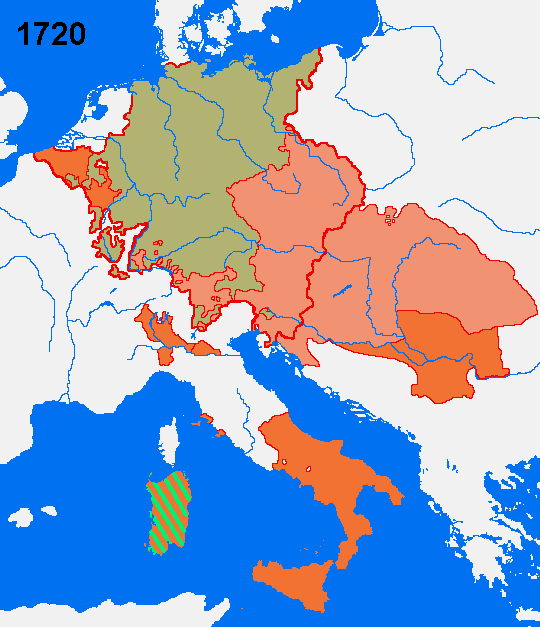
 = Austria
= Austria
 = Other parts of the Holy Roman Empire
= Other parts of the Holy Roman Empire |
 = Territorial gains 1714, 1718 and 1720
= Territorial gains 1714, 1718 and 1720
 = Temporary territorial gain 1714-20
= Temporary territorial gain 1714-20 |
The King Carlos II of Spain had no children and because of his poor health
had the European monarchs been planning the partition of the Spanish realm
ever since Carlos II became king 1665. The main claimants were France and
Austria and two partition treaties had been proposed 1698 and 1700 to settle
the issue. But the Austrian emperor Leopold I had rejected both treaties because
he wanted his son Charles to inherit the entire Spanish realm. The Spaniards
themselves wanted to preserve an unpartitioned realm, but they considered France
to be more able to defend it from the other claimant. So Carlos II bequeathed
his kingdoms to French king Louis XIV's younger grandson. This ignited the
War of the Spanish Succession, which lasted 1701-1714 and resulted in a
partition that was less favourably than the partition treaties Austria
previously turned down. Even so, it was a very large expansion of Austria's
territory and large parts of modern Belgium and Italy came under Vienna's rule.
More was to come because when a Turkish attempt to reconquer territory lost to
Venice in the Peace of Karlowitz triggered a Austrian declaration of war in
1715 and in the following peace treaty from 1718 was Austria enlarged with the
remaining parts of Hungary and adjacent territories. A Spanish attempt to reconquer their lost Italian possessions 1717-1720 failed, but resulted in
Austria exchanging Sardinia with Sicily from the duke of Savoy. Austria had
now reached its largest extent ever.
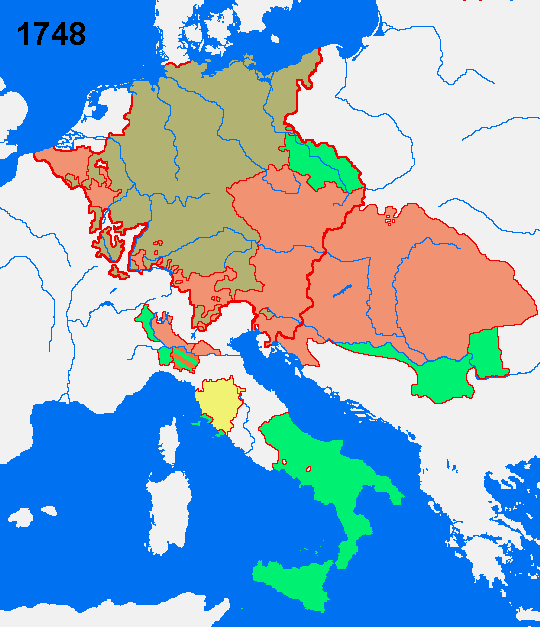
 = Austria
= Austria
 = Other parts of the Holy Roman Empire
= Other parts of the Holy Roman Empire
 = Tuscany (ruled by Maria Theresia's husband 1737-65)
= Tuscany (ruled by Maria Theresia's husband 1737-65) |
 = Austrian territorial losses
= Austrian territorial losses
 = Temporary gain 1735-48
= Temporary gain 1735-48
|
Even though Austria was larger than ever before, it had one great problem.
Emperor Charles VI was the last surviving male member of the house of Habsburg
and he had no sons. His reign 1711-1740 was therefore focused on getting
international guarantees for the so called Pragmatic Sanction, which would ensure
the succession of his daughter Maria Theresia to an unpartitioned Austrian empire.
However, already during Charles VI's lifetime would Austria diminish in size. The
War of the Polish Succession 1733-35 against France resulted in the loss of the
Kingdom of Both Sicilies in southern Italy as well as parts of Lombardy in
northern Italy. Apart from this was Maria Theresia's husband Franz Stephan forced
to exchange his duchy of Lorraine with Tuscany 1737. In exchange for the losses in
Italy acquired Austria the considerably smaller duchy of Parma. A new Turkish
war 1737-39 led to the loss of those parts of Bosnia, Serbia and Wallachia that
had been gained in 1718. The international guarantees also proved to be worthless
when Charles VI died 1740 and Prussia, Bavaria and Saxony made claims to Austrian
territory with support from France. The expected partition of the Austrian monarchy
did not happen however, and Maria Theresia managed to put up a successful defence
of Austria during the War of the Austrian Succession 1740-48). But she was still
unable to prevent Prussia from conquering most of Silesia. She was also forced to
cede Parma and additional parts of Lombardy. Because the Habsburg dynasty technically
had become extinct was Maria Theresia's husband Franz Joseph elected to Holy Roman
Emperor in 1745 and their sons took the name Habsburg (now as the house of Habsburg-Lorraine).
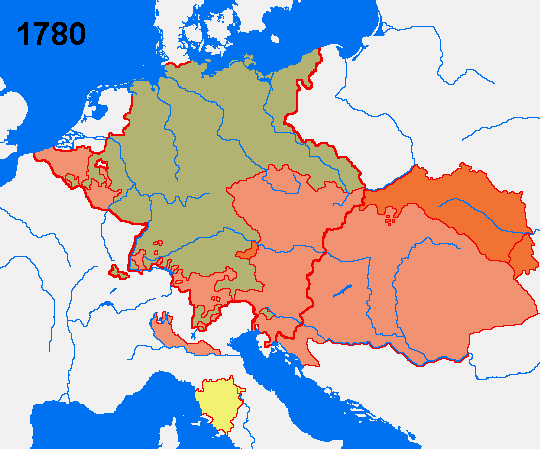
 = Austria
= Austria
 = Territorial gains 1772, 1775 and 1779
= Territorial gains 1772, 1775 and 1779 |
 = Other parts of the Holy Roman Empire
= Other parts of the Holy Roman Empire
 = Tuscany (ruled by a Habsburg cadet line)
= Tuscany (ruled by a Habsburg cadet line) |
The War of the Austrian Succession had revealed serious deficiencies in
the Austrian state. The decades after 1748 were spent on reforming the
Austrian army and administration. A very desired objective was also the reconquest of the rich province of Silesia, which in 1742 had been lost to
Prussia and thus made it possible for this kingdom to become a serious rival
to Austria's position as the leading German state. The Austrians would however
fail to reclaim Silesia despite an alliance with Russia and France during the
the Seven Years' War 1756-63, although their army restored its reputation.
Austria participated in the first partition of Poland in 1772 together with
Prussia and Russia and gained Galicia and Lodomeria. With the consent of
Russia would Austria also occupy the adjacent territory of Bukovina in 1774
and the once so feared Ottoman Empire had no choice than to formally cede this
territory the following year. Joseph II who had succeeded his father as Holy
Roman Emperor in 1765 and until his mother Maria Theresia's death in 1780
shared power with her, was the driving force in this peaceful (but aggressive)
expansion and he also wanted to annex Bavaria. A good opportunity for this came
in 1777 when the branch of the Wittelsbach dynasty that had ruled Bavaria became
extinct. Prussia would however not tolerate such a large Austrian expansion on
German territory and thus initiated the War of the Bavarian Succession (1777-79).
Joseph had to settle with just a small strip of Bavarian territory (Innviertel)
in the following peace treaty.
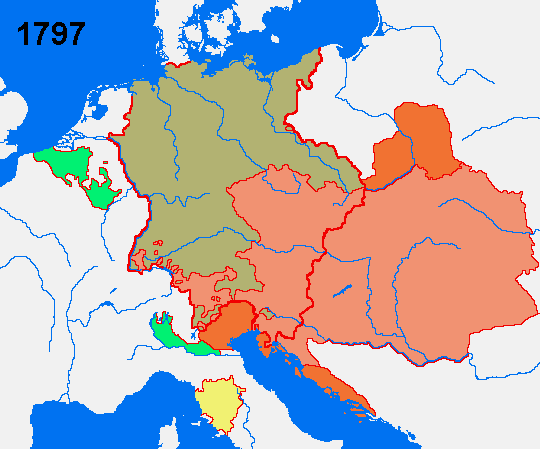
 = Austria
= Austria
 = Territorial gains 1795 and 1797
= Territorial gains 1795 and 1797
 = Territorial losses 1797
= Territorial losses 1797 |
 = Other parts of the Holy Roman Empire
= Other parts of the Holy Roman Empire
 = Tuscany (ruled by a Habsburg cadet line)
= Tuscany (ruled by a Habsburg cadet line)
|
After the death of Maria Theresias in 1780, Joseph II began with a feverish
activity to introduce modernising reforms in the spirit of the Age of Enlightenment
These were however met with great resistance in Hungary and in the Austrian
Netherlands (modern Belgium) and many reforms were withdrawn after the death of
Joseph in 1790. Joseph II had also during the 1780s tried to exchange the
Austrian Netherlands with Bavaria, but Joseph II and the Bavarian elector could
not agree on how much money these territories were worth. Similar plans to
partition the Ottoman Empire with Russia were equally unsuccessful. Austria
reclined from participation in Poland's second partition in 1793 in exchange for
a promise of an annexation of Bavaria (which never happened)). But Austria did
participate in the third partition of Poland, which wiped out Poland from the map,
and received West Galicia
Of great importance was the French revolution in 1789, which led to a French
declaration of War against Austria in 1792. Despite the fact that Austria was a
part of a large coalition of countries opposing the French republic would they be
defeated by the French revolutionary armies. When a peace treaty was concluded at
Campo Formio in 1797 had France conquered all lands west if the Rhine, including
the Austrian Netherlands. These losses were added by the remaining Austrian
possessions in Italy. As a compensation for this was Austria allowed to annex the
Republic of Venice.
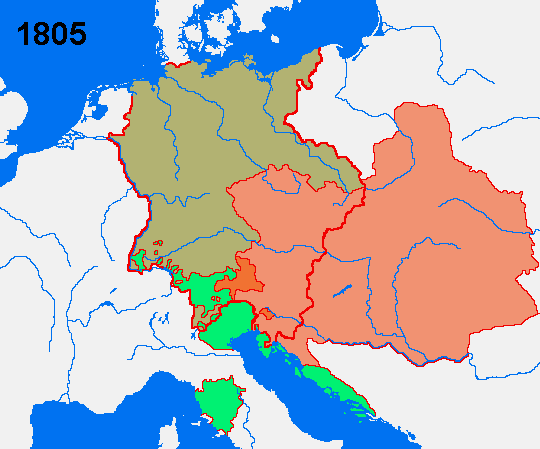
 = Austria
= Austria
 = Other parts of the Holy Roman Empire
= Other parts of the Holy Roman Empire |
 = Territorial gains 1805
= Territorial gains 1805
 = Territorial losses 1805
= Territorial losses 1805 |
The wars against the revolutionary France would however not end with the
peace of Campo Formio. A Second Coalition War was fought 1799-1802, which for
Austria's part ended in 1801 with a confirmation of the Campo Formio terms.
The Third Coalition War resulted in a French occupation of Vienna and was
decided by the Three Emperors Battle of Austerlitz. Austria was forced to
cede the former Republic of Venice and Further Austria (including Tyrol which
became Bavarian). The Habsburg cadet line who ruled Tuscany was also deposed.
The only territory Austria received as compensation was the Archbishopric of
Salzburg, Mozart's native country. Because the French dictator Napoleon
Bonaparte had coronated himself emperor in 1804, had Franz I the same year
declared himself hereditary emperor of Austria (in addition to the existing
title Holy Roman Emperor).
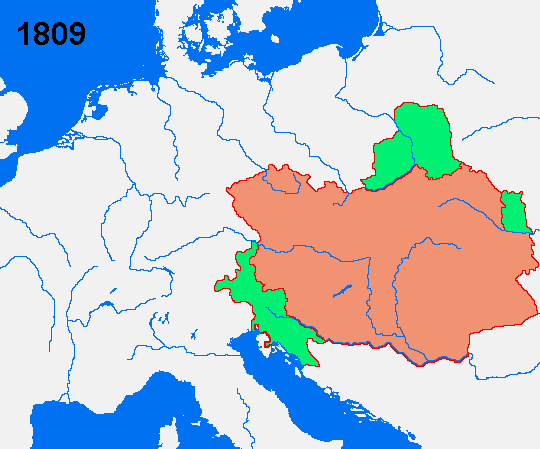
 = Austria
= Austria
 = Territorial losses 1809
= Territorial losses 1809
The title Holy Roman Emperor was lost 1806 when Napoleon dissolved the Holy
Roman Empire and replaced it with the French led Confederation of the Rhine.
Three years later Austria participated foolishly in the Fifth Coalition War
against France. This was not more successful than the previous one and Austria
lost Innviertel, Salzburg, Carinthia, Carniola and the western parts of Croatia
as well as West Galicia and a part of East Galicia.
The history of Austria continues on this page. |

